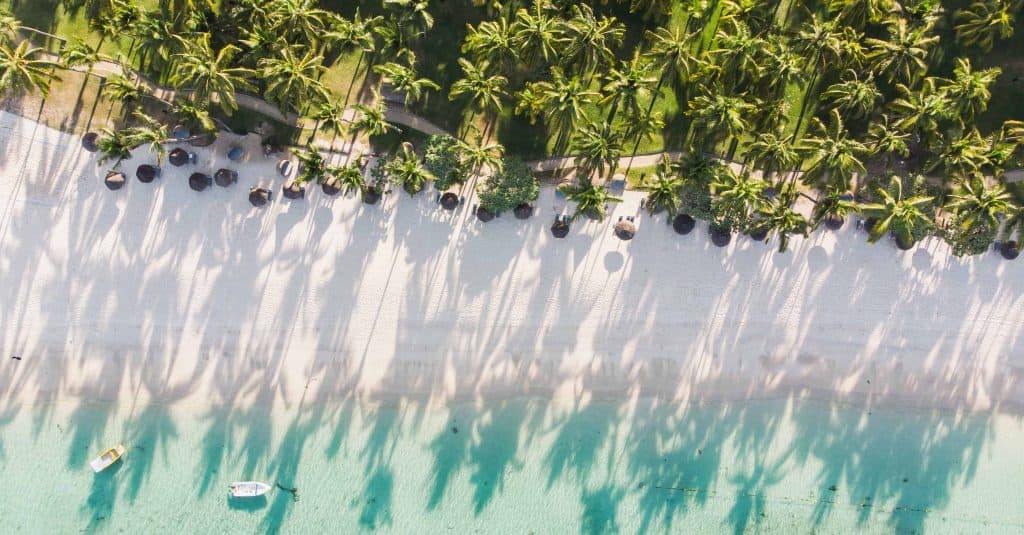Who hasn’t dreamed of escaping to a desert island? Powder white sand, warm azure seas, and lazing in hammocks strung between two palm trees pretty much sums up the vision we all have in our heads of our beach paradise. So let’s head off to the Indian Ocean where these dreams can all come true, whether it is for a romantic holiday for two, the perfect honeymoon or a family holiday of a lifetime.
The top three Indian Ocean beach destinations are Mauritius, The Seychelles and The Maldives but how do you choose between them (a nice problem to have!)? Flight times are similar ranging between 10-12 hours from the UK and jet lag is minimal with a 3-4 hour time difference. White beaches, blue seas and balmy weather are also a given for all three and yet they aren’t as similar as you might first think. Each has its own individual charm offering visitors a different experience. Therefore, it’s not so much a matter of which is best per se, but finding out which suits you best.
Each is perfect in their own way but which one most closely matches your fantasy? Read on to find out.

Mauritius
Unlike the Seychelles and the Maldives archipelagos, Mauritius is one large island (just a little bigger than London). Therefore it won’t hit the ‘lost on a desert island’ feeling you might be looking for but if you’re up for somewhere busier with plenty of activity then Mauritius may be your perfect island.
Being a larger island with a well established tourist industry brings the benefit of a wide choice of accommodation from more affordable modest establishments to glamorous 5 star luxury resorts. Beach front options tend to be large resort type hotels with the benefit of multiple restaurants, in house water sport centres, activity programmes, gyms, spas and kids/teens clubs but it is possible to seek out smaller, boutique options. Many hotels also offer private villas for a more intimate stay combined with the excellent on site facilities.
If you like to mix your beach life with a bit of sightseeing, it is very easy to travel around by taxi or car to venture further afield and get a flavour of Mauritian culture. Discovered by Arab traders and colonised by the French, Dutch and British before gaining independence in 1968, it certainly has an impressively rich and varied history for its modest size. Explore the colonial capital city with its vivid colours and cultural contrasts or journey back in time with a drive along the historic tea route. Sugar plantations are in abundance and La Rhumerie de Chamarel is one of the rare rum distilleries still in activity to cultivate its own sugarcane. Take a tour and sample some cocktails before dinner in their restaurant.
The volcanic, mountainous geography is great for hiking. Black River Gorges National Park is the biggest and best with fantastic views and waterfalls. Or experience an aerial adrenaline rush through a thrilling zip-line adventure at the Vallée des Couleurs reserve.
Ideal for: More affordable luxury. Active couples and families who might get fidgety being on the beach every day. The variety needed to keep everyone happy on a multigenerational holiday.
Best time to go: Being sub tropical you can expect good beach weather all year. It is drier in their winter (May to October) but also slightly cooler and can get windy so you might want to avoid the east coast during July and August. January and February are cyclone season so best avoided. October – December are the hottest months but relieved by heavy downpours . April and May are a good time to visit as temperatures are still warm and largely dry and it is also a quieter time ahead of the busy school holiday period.
Good to combine with: An African safari holiday; Madagascar or Reunion
The Seychelles
Sitting about 1000 miles directly above Mauritius and just south of the equator are the Seychelles. Consisting of 115 islands (some granite, some coral), the Seychelles have seen very little development offering a wilder, more back to nature experience than either the Maldives or Mauritius. The 3 main islands – Mahe, Praslin and La Digue – are quite large, while the other islands are medium-sized to tiny. Most are uninhabited.
The beaches are arguably the most picture perfect in the world, ticking all the boxes – the softest of soft white sand, clear blue waters, lush, tropical jungle backdrop and those iconic dark, weathered granite boulders providing the perfect contrast. Almost half the country is protected and the geography gives rise to a unique indigenous flora and fauna (such as the legendary coco de mer palm yielding the world’s largest seed) so this is the place to come for nature lovers. Go hiking in the virgin jungle and keep your eyes peeled for the world’s smallest frog, watch turtles laying their eggs in the soft sands, witness the giant land tortoises and enjoy some of the most spectacular swimming, snorkelling, diving and birdlife.
The Seychelles receives significantly less tourists than either the Maldives or Mauritius as the government is very focussed on maintaining a balance between sustainable tourism and economic growth. Resorts are more intimate and definitely luxurious but in a less glossy, more natural way so perfect for that ‘getting away from it all’ vibe. There are some amazing high end options located on their own insanely beautiful islands. It is easy to island hop so it is definitely worth taking the opportunity to sample the simplicity of creole island life, enjoy the numerous jungle hiking trails or hire a bicycle on the larger islands and then head off to a more secluded hideaway for deserted beaches and crystal waters. But be aware no motorised water sports are permitted in this eco friendly destination.
Ideal for: Adventurous nature lovers. Off the beaten track, low-key vibe.
Best time to go: The temperature in the Seychelles is around 30°C (86°F) all year round, with a mixture of sunshine and tropical showers, and sea breezes which disperse the humidity. However, the Seychelles’ positioning, just seven degrees south of the Equator and away from large land masses in the Indian Ocean, makes it very hard to predict the weather or rely on online forecasts. That said there is no awful time to visit but trade winds can cause rough seas together with seaweed impairing the swimming conditions at some resorts so it is important to choose your location accordingly.
April and October are calmer as they are between trade winds. October is especially so bringing excellent diving conditions and the migrating whale sharks will have arrived.
Good to combine with: An African safari
The Maldives
Sitting on the equator, the Maldives are south west of Sri Lanka and India. The long archipelago of 1200 tiny coral islands is scattered across 500 miles of Indian Ocean within clusters of 26 atolls. They really are just patches of coral peeking above the surface of the sea and oh! So beautiful!
This is the top choice for those looking for the ultimate, decadent desert island experience. Exclusive resorts on their own pristine island with total privacy, Michelin starred dining and wine cellars to match, not forgetting the unrivalled spas and butler serviced, overwater villas on stilts. With the islands being more dispersed, island hopping is trickier and more expensive so visitors tend to make their choice and stay put to luxuriate in everything on offer. And there are plenty of options to choose from whether you are looking for your own totally private island, a romantic hideaway or a larger resort for all the family. Come to relax, unwind and enjoy being thoroughly pampered in this exclusive enclave.
If diving and snorkelling are your top priority, look no further. The Maldives offer some of the clearest waters and best experiences in the world, not just the Indian Ocean. Resorts tend to have their own dive schools and benefit from their own house reef right off the beach. There is even the opportunity to enjoy the colourful marine life whilst dining in the world’s first undersea restaurant, 5m beneath the waves. Sunsets are magical and you might manage to muster up the energy for a beach picnic or dolphin cruise.
Ideal for: Exceptional marine life and perfect diving conditions. Enjoying a celebrity lifestyle in paradise.
Best time to go: The equator passes through the Maldives so they experience a tropical climate with no real fluctuations in temperature. January to April are the driest months, with little rain and low humidity, making this peak season at the resorts. This also means the waters are clearer for good visibility when diving and snorkelling. Temperatures are still warm from May to December, but rain is more likely and there is a risk of storms. However, even during this period there are usually long spells of bright sunshine.
Good to combine with: A trip to India, Sri Lanka or UAE


